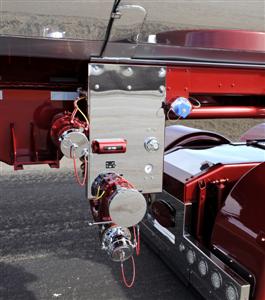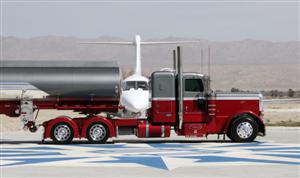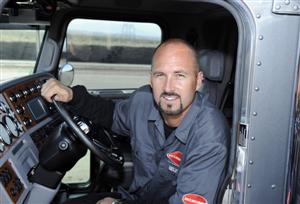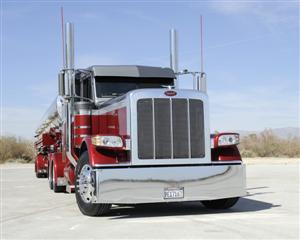COVER FEATURE - APRIL 2009
JET-POWERED PETE
CHRIS HASTY DELIVERS JET FUEL WITH STYLE
By Daniel J. Linss - Editor
When you deliver jet fuel for multi-million dollar corporate and personal aircraft, you have to look good. It all comes down to service with style – and nobody does it better than Chris Hasty of Jetspeed Inc. out of Lakewood, CA. Over the last year, Chris and his stylish rig have made a name for themselves in the jet fuel delivery business by offering customers prompt service with no hassles. In fact, many of the upscale airports that he services in California have been requesting him by name when they order their fuel. And in a competitive industry like this, that is no easy task – especially when you are just a single truck owner operator.
 Chris Hasty (41) grew up in Grants Pass, Oregon. After graduating from high school, his parents got divorced and his father moved to Southern California and started a construction company. His dad convinced him not to go to college, but instead, to come work for him. Chris worked with his dad for eight years, and while there, he got his CDL and learned how to drive trucks in tight conditions around the construction sites. In 1994, his father sold the business and Chris found himself looking for a job. One day he saw a Beneto truck on the road (they were known for their super-clean tankers) and decided that he just had to work there. He drove for them for about a year, and then switched over to Fuel Controls, Inc (FCI), hauling jet fuel and AV gas (for planes with piston engines) for over 12 years. Later, when he was given the opportunity to buy his own truck and become an owner operator, he jumped at the chance.
Chris Hasty (41) grew up in Grants Pass, Oregon. After graduating from high school, his parents got divorced and his father moved to Southern California and started a construction company. His dad convinced him not to go to college, but instead, to come work for him. Chris worked with his dad for eight years, and while there, he got his CDL and learned how to drive trucks in tight conditions around the construction sites. In 1994, his father sold the business and Chris found himself looking for a job. One day he saw a Beneto truck on the road (they were known for their super-clean tankers) and decided that he just had to work there. He drove for them for about a year, and then switched over to Fuel Controls, Inc (FCI), hauling jet fuel and AV gas (for planes with piston engines) for over 12 years. Later, when he was given the opportunity to buy his own truck and become an owner operator, he jumped at the chance.
After spotting Chris and his truck out on the road, we tracked him down and set up a photo shoot. We met him out at Jacqueline Cochran Regional Airport, a small yet busy airfield just outside of Palm Springs, in Thermal, California. His customer at the location, Tradition Aviation, was kind enough to grant us full access to anywhere we wanted to go. Tradition Aviation, an independent fixed base operation (FBO), provides fuel, storage and many other specialty services to their discriminating clients who operate personal and corporate aircraft. With over 40 years of combined experience, General Manager Penny Nelson and Director of Operations Ann Goodwyn have taken convenience to a country club level. And why wouldn’t they? After all, many of the jets they service, including the one we used in several of our pictures, are worth tens of millions of dollars.
 Once at the airport, Chris decided to dump the load he had onboard, so we got a brief lesson in jet fuel and jet fuel delivery. The quality and purity of jet fuel is very important, so it is checked and rechecked many times during the delivery process. Once he arrives at a location, Chris is required to park the truck and turn it off for ten minutes to allow the fuel to settle. He then drains out a small sample into a bucket and someone from the airport tests the fuel’s gravity (weight). The fuel has to be within 1% of the stated purity level that it was when it was loaded at the refinery. This also helps to ensure that the refinery loaded the correct fuel onto the truck. When the truck unloads into the storage tank at the airport, the fuel is filtered to make sure that no water has accumulated. When it is pumped from the storage tank into the delivery truck that goes out on the tarmac, it is filtered again. It is filtered one more time when it goes into the airplane’s fuel tanks (which also have a filter). If there is any water in the fuel, it can freeze when the aircraft reaches a high altitude, causing the fuel system to fail and, possibly, a catastrophic accident.
Once at the airport, Chris decided to dump the load he had onboard, so we got a brief lesson in jet fuel and jet fuel delivery. The quality and purity of jet fuel is very important, so it is checked and rechecked many times during the delivery process. Once he arrives at a location, Chris is required to park the truck and turn it off for ten minutes to allow the fuel to settle. He then drains out a small sample into a bucket and someone from the airport tests the fuel’s gravity (weight). The fuel has to be within 1% of the stated purity level that it was when it was loaded at the refinery. This also helps to ensure that the refinery loaded the correct fuel onto the truck. When the truck unloads into the storage tank at the airport, the fuel is filtered to make sure that no water has accumulated. When it is pumped from the storage tank into the delivery truck that goes out on the tarmac, it is filtered again. It is filtered one more time when it goes into the airplane’s fuel tanks (which also have a filter). If there is any water in the fuel, it can freeze when the aircraft reaches a high altitude, causing the fuel system to fail and, possibly, a catastrophic accident.
One thing that we learned is that jet fuel, contrary to popular belief, is not very flammable. In fact, it is downright hard to ignite, but once it does, look out! When regular gasoline burns, it is not really the liquid burning, it is the fumes. Jet fuel has no fumes, so it is rather stable. But once the liquid is compressed and ignited, it burns twenty times hotter than regular gasoline. Jet fuel is nothing more than ultra-refined diesel fuel with a very high sulfur content. But, since it has no lubricants in it, jet fuel would not be good to put in your truck.
 The jet that you see in the background of some of the pictures (including the centerfold) is a $40 million Cessna Citation X (Ten). The Citation X is a long range medium business jet. With a top speed of Mach .092 (703 mph), it is the fastest civilian jet made. Powered by two Rolls Royce turbofan engines, this sleek jet has been in production since 1996 and seats 8-12 passengers, along with two crew members. It has a range of 3,070 nautical miles and cruises at just a hair less than the speed of sound. So, as we said before, when your business is to serve customers who own and/or operate vehicles like these, you can’t show up in a dirty, rattle-trap truck with dents and rust. You need to have a sophisticated ride with some style – you need a fancy new Peterbilt with a matching tanker trailer and lots of custom accessories.
The jet that you see in the background of some of the pictures (including the centerfold) is a $40 million Cessna Citation X (Ten). The Citation X is a long range medium business jet. With a top speed of Mach .092 (703 mph), it is the fastest civilian jet made. Powered by two Rolls Royce turbofan engines, this sleek jet has been in production since 1996 and seats 8-12 passengers, along with two crew members. It has a range of 3,070 nautical miles and cruises at just a hair less than the speed of sound. So, as we said before, when your business is to serve customers who own and/or operate vehicles like these, you can’t show up in a dirty, rattle-trap truck with dents and rust. You need to have a sophisticated ride with some style – you need a fancy new Peterbilt with a matching tanker trailer and lots of custom accessories.
After securing the financing through a friend and business associate, Chris ordered his dream rig – a brand new 2008 Peterbilt 389 and a custom Weld-It tanker trailer. Both the truck and trailer were ordered late in 2006 from Rush Peterbilt in Pico Rivera, CA, but it took one and a half years to actually get them, build them, and then put them on the road. The rig finally made its maiden voyage on April 15, 2008 – and has hardly stopped ever since. Chris services several flight based operations (FBOs) at small airports in California including San Luis Obispo, Santa Barbara and Thermal (Palm Springs area). These airports and FBOs service upscale clients in a laid-back, relaxed environment. They also make it easy for these clients to access their jets.
 The Peterbilt, which is powered by a 600 hp Cummins ISX and a 13-speed transmission, was ordered with a 36-inch flattop sleeper and no cab lights. The split paint scheme was also ordered from the factory – Slate Grey on the top and Radiant Fire on the bottom – but when the trailer was finished, the grey on it did not match the tractor. The grey on the truck was repainted, and then a Platinum breaker stripe was added between the two colors. The breaker stripe was also accented with a thinner line of Crushed Metal Flake, and then the entire truck was buffed out. The air cleaners were painted to match the paint scheme, as were the headlight buckets, battery boxes and fuel tanks.
The Peterbilt, which is powered by a 600 hp Cummins ISX and a 13-speed transmission, was ordered with a 36-inch flattop sleeper and no cab lights. The split paint scheme was also ordered from the factory – Slate Grey on the top and Radiant Fire on the bottom – but when the trailer was finished, the grey on it did not match the tractor. The grey on the truck was repainted, and then a Platinum breaker stripe was added between the two colors. The breaker stripe was also accented with a thinner line of Crushed Metal Flake, and then the entire truck was buffed out. The air cleaners were painted to match the paint scheme, as were the headlight buckets, battery boxes and fuel tanks.
Most of the truck’s custom pieces were made by the guys at Aranda Truck Accessories. These pieces include the custom shock box on the back of the sleeper, stainless panels mounted up and underneath the fenders in the wheel wells, “breather blanks” mounted on the front of the air cleaners, as well as ones with red lights mounted on the back. Aranda also made the stainless deck plate, custom drop visor and four light bars. This was the first Model 389 that Aranda had built any accessories for, so many of them were first-off pieces. Chris also had someone cut his logo out of four separate pieces of thick aluminum and then mounted them on the battery boxes on the truck, as well as on the rear light bars of both the truck and trailer. Mounting the aluminum plates on short studs, he back-lit the logos with red lights. Other extras that were installed on the truck include cab and sleeper extensions, Haastyle double hump fiberglass fenders, 7-inch Dynaflex pipes and a 20-inch boltless bumper with a slight rake on each end. The tractor has very few visible lights (but plenty of hidden ones) and a minimal amount of chrome. At night, when the headlights are off, all you see coming at you is an eerie red glow.
 The trailer, on the other hand, has about 50 LEDs, not to mention plenty of shiny chrome and polished stainless. The 2008 tanker trailer, which can haul about 7,600 gallons of fuel, was custom made for Chris by Weld-It in Los Angeles, CA. Built specifically to haul jet fuel exclusively, the trailer was made with only two compartments and split loading heads, and then the dual compartments were plumbed together underneath. What this means is that Chris can load both compartments at the same time, and then unload them both through one tube. This allows him to load and unload faster and easier than anyone else.
The trailer, on the other hand, has about 50 LEDs, not to mention plenty of shiny chrome and polished stainless. The 2008 tanker trailer, which can haul about 7,600 gallons of fuel, was custom made for Chris by Weld-It in Los Angeles, CA. Built specifically to haul jet fuel exclusively, the trailer was made with only two compartments and split loading heads, and then the dual compartments were plumbed together underneath. What this means is that Chris can load both compartments at the same time, and then unload them both through one tube. This allows him to load and unload faster and easier than anyone else.
Originally, Chris was going to install double hump fiberglass fenders on the trailer, like the ones on the tractor, but the size of the spread was different, so he had a guy at Weld-It make him exact replicas (with the correct spread) out of aluminum. Everything on the trailer has to be aluminum – not only because it is lighter, but also because it is a soft metal that does not spark when hit or dropped. Chris had all of the tubes and valves, and even his plastic buckets, painted to match the truck, and then had Artistic Plating in Signal Hill, CA chrome plate all of his loading heads. To finish the trailer off, most of the tank was painted Slate Grey, except for the front and rear bulkheads, as well as a strip along each side, which was left unpainted for that “old school” mirror look (Chris loves to watch people check themselves out in the reflection as they pass).
 Over time, Chris would love to build up a fleet of tankers and run his operation similar to the way Beneto ran theirs – hire quality drivers who care for their equipment, and then give them a nice truck to drive. But for now, it is just Chris and his one truck. But that is still pretty good. Looking back, he wishes that he would have gone out on his own a lot sooner. What he really wants to do is spend more time with his wife and kids, and he is hoping that his present (and future) success will help make that dream a reality. Chris and his wife Diana (Dede) have been married for six years. The young couple has two small daughters – Brooke is 3 and Ella is just 1. Chris also has a twelve-year-old daughter named Alex from a previous relationship.
Over time, Chris would love to build up a fleet of tankers and run his operation similar to the way Beneto ran theirs – hire quality drivers who care for their equipment, and then give them a nice truck to drive. But for now, it is just Chris and his one truck. But that is still pretty good. Looking back, he wishes that he would have gone out on his own a lot sooner. What he really wants to do is spend more time with his wife and kids, and he is hoping that his present (and future) success will help make that dream a reality. Chris and his wife Diana (Dede) have been married for six years. The young couple has two small daughters – Brooke is 3 and Ella is just 1. Chris also has a twelve-year-old daughter named Alex from a previous relationship.
 A project like this truck could never be done alone – it takes a lot of help. First and foremost, Chris wanted to thank his family for their support and patience. He also wanted to thank Avfuel Corp., Western Petroleum, San Luis Jet Center, Tradition Aviation, Signature Flight Support, Weld-It, Aranda Truck Accessories, Quality Fleet & Truck Center, Rush Peterbilt, Dynaflex and Magic Truck Accessories. These companies contributed major amounts of help to this project, and for that, Chris is very grateful to all of them.
A project like this truck could never be done alone – it takes a lot of help. First and foremost, Chris wanted to thank his family for their support and patience. He also wanted to thank Avfuel Corp., Western Petroleum, San Luis Jet Center, Tradition Aviation, Signature Flight Support, Weld-It, Aranda Truck Accessories, Quality Fleet & Truck Center, Rush Peterbilt, Dynaflex and Magic Truck Accessories. These companies contributed major amounts of help to this project, and for that, Chris is very grateful to all of them.
It’s been said that Rolex does not sell watches – they sell prestige and status. With that in mind, it could be said that Chris does not deliver jet fuel – he delivers service with style. Yes, jet fuel pays the bills, but it is his commitment to excellence that keeps his customers calling back. And although Chris Hasty’s Peterbilt may not actually be jet-powered, his company, and his success, is certainly powered by jet fuel.
